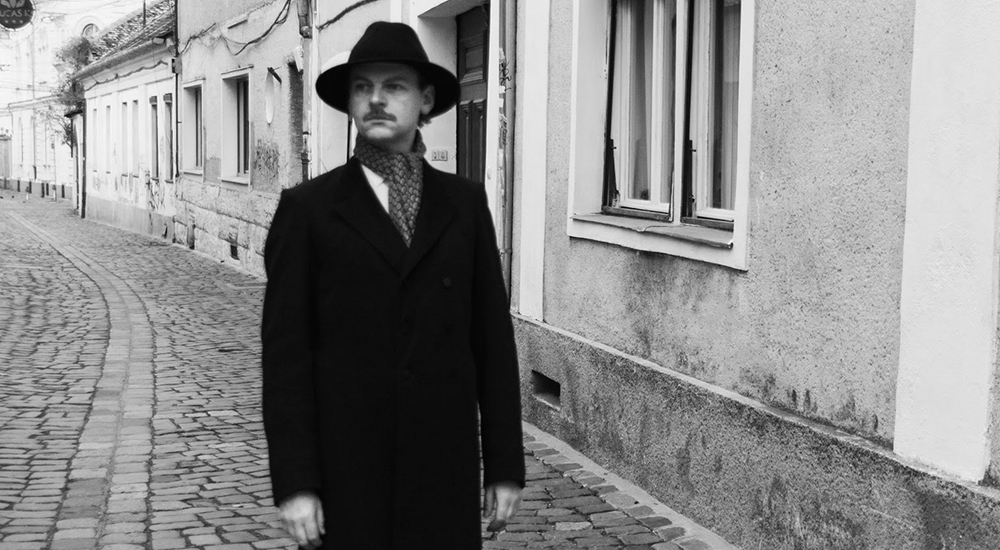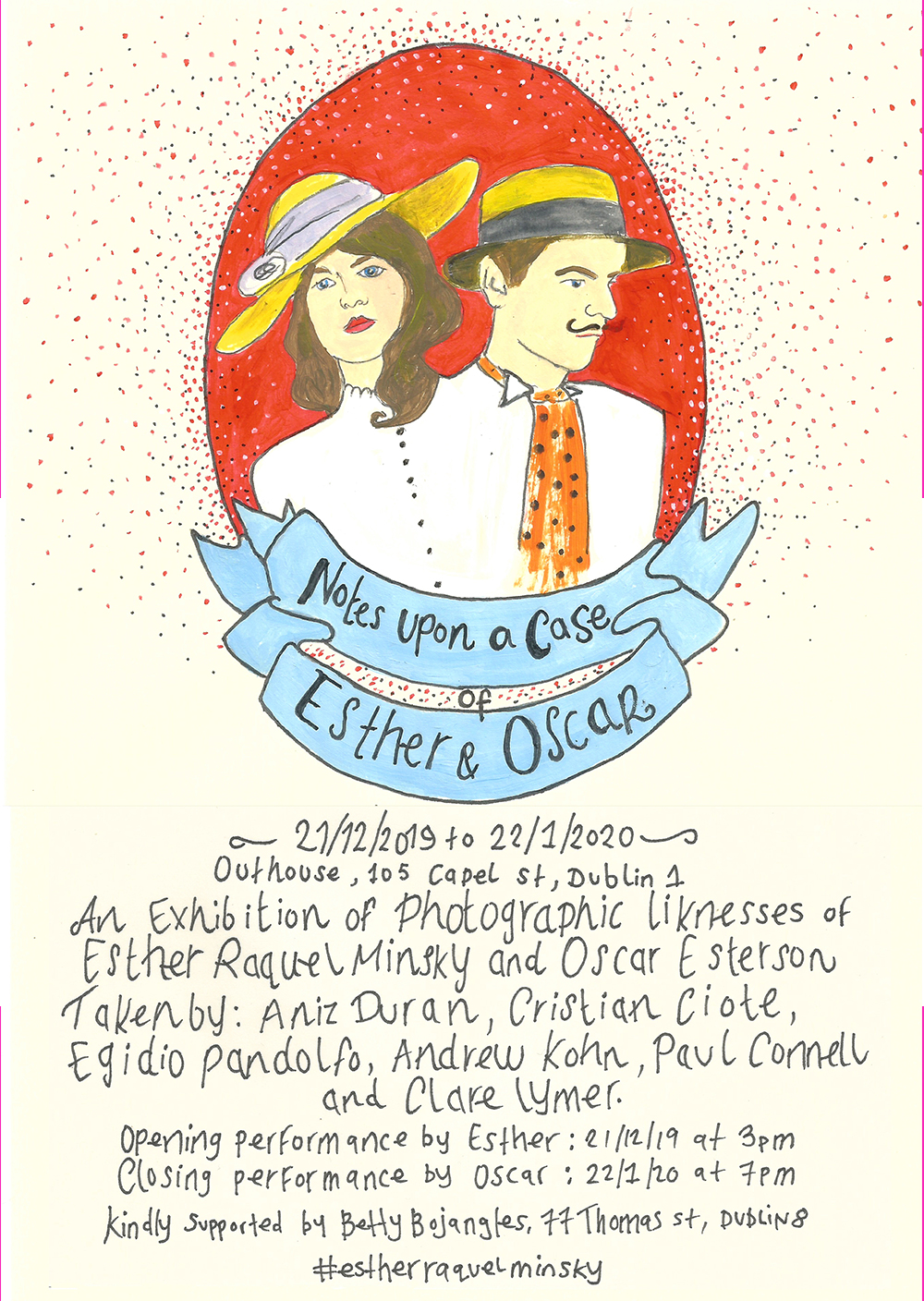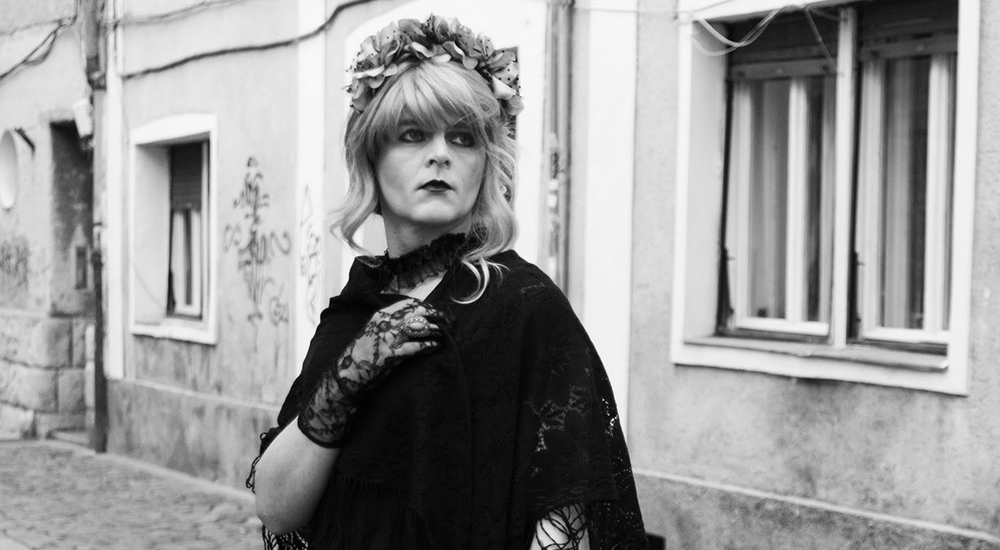A new exhibition entitled ‘Notes Upon A Case of Esther and Oscar’ will take place in the Outhouse Red Room from December 21. It will showcase the work of a number of photographers Denis Kehoe has collaborated with in recent year in shooting their alter-egos Esther Raquel Minsky and Oscar Esterson.
The exhibition will open with a monologue performed by Esther this coming Saturday, December 21 with the exhibition opening from 3 – 5 pm. The exhibition will run in Outhouse until January 22 and Denis Kehoe will close it with the same monologue, this time performed by the male version of Esther, Oscar, that evening.
We chatted with Denis Kehoe about their inspiration and the journey that brought this exhibition to life.
What is your inspiration for this exhibition?
I have always been interested in the Gothic idea of the Double and in stories of transformation, as well as issues around the expression of gender and sexuality. For the last few years, I have been working with different photographers in Ireland and abroad, capturing my alter-egos Esther Raquel Minsky and Oscar Esterson in different places and in different guises. With this exhibition, I am interested in tracing the narratives of the characters through the photographers’ work. It will be interesting to see what conversation the images have with one another when they are gathered in the same room. The Red Room at Outhouse is a very special place, luxurious and very atmospheric. I am really excited about presenting the work there and am really thankful to Sarah, Leanne and all the other gems there who have been so supportive of the project.

What was it like working with different photographers? Does each one capture a different point of view?
It has been really interesting and exciting working with the six different photographers who created portraits of Oscar and Esther: Aniz Duran, Cristian Ciote, Egidio Pandolfo, Andrew Kohn, Paul Connell and Clare Lymer. I am really grateful to all of them for their generosity, time and enthusiasm. Some of the photographers I knew already, and some not. I have worked with Aniz Duran the most, a Mexican photographer and artist based in Dublin and she has had great patience with regard to the project. One of the things I really enjoy is spending time with the photographers; collaborating in terms of discussing the costumes, finding spaces to shoot in, going through the captured images etc. The conversations, the journey in and out of the characters and the different worlds where they are photographed, as well as the relationships that develop along the way, even if only for a few hours, has been a really fascinating experience for me. It seems to me that the collaborations with these different photographers is itself transformative so that you leave the shoot a slightly different person than you were before.
All the photographers have different styles and different ways of working. Some worked in colour, some in black and white, some used film and some digital, some took hundreds of shots, some much less. Some were interested in capturing images of Esther and Oscar for their own projects initially and then I asked if they would also participate in mine, and it is nice to think their images will go out into the world in different contexts. What was also interesting was wandering out into the world, both in Dublin, in Brazil and Transylvania, and the tension and excitement of emerging as the characters in broad daylight. It is always interesting to see whether people will react or not, interact or not. Thankfully there were never any negative consequences for my gender play and subversion in any of the places where we worked.
How did you develop your alter egos?
The alter-egos are an outgrowth of my fourth novel, which I am currently re-writing. That book is set in three cities: Warsaw, Dublin and Rio de Janeiro at the turn of the last century. The narrator is a Polish Jewish female photographer who lives and grows up in all three cities. The novel is about theatre, clothing, prostitution, travel, orchids, gender and sexuality.
Some of the characters in the story are women who work in the sex trade in Warsaw and in Brazil and one of the inspirations for the book was the true story of Jewish women from Poland and the surrounding countries who ended up working in the sex trade in places such as Brazil and Argentina in the second half of the nineteenth century and the earlier decades of the twentieth century. Some of the women and girls were tricked into going to these places through false marriages or the promise of work, others may have went of their own accord. During my first research trip to Rio de Janeiro five years ago, I became interested in engaging with the spaces in the city where these women lived and worked and this led to the development of the fictional character of Esther Raquel Minsky, a girl from Eastern Europe who ends up in Rio. I put together seven looks for the character, from a girl from the village to her life as a powerful older woman in Rio. This character was first photographed in Rio by André Henrique.

In the following years, I developed a seminar series where I work at the National College of Art & Design in Dublin called The Female City. This course explores the representation of different female ‘types’ and figures from the nineteenth and early twentieth century including the suffragette and the ‘hysteric’. With this course, I became interested in exploring the idea that Esther herself has different faces and identities, so that one day she presents as a seamstress, another day as a flaneuse, another day as a woman working in the sex trade. As well as the photographic collaborations, I have explored the character through a series of performances, such as my recent participation in the wonderful Soul Noir Festival and a Bloomsday performance in Lucy’s Lounge vintage clothes shop in Temple Bar.
Some years into the constantly evolving project, I also became interested in exploring certain male ‘types’ from the same period as Esther’s life: the dandy, the sailor, the circus clown etc. Hence the character of Oscar Esterson was born. Both he and Esther are a curious double act, born of the same body and sometimes appearing in the same spaces just minutes apart.
In terms of the development of the look of the characters, certain people have been really instrumental and endlessly supportive, such as Charlie at Betty Bojangles clothes shop on Thomas Street, Deirdre at Lucy’s Lounge, Eithne from The Green Door Market and Bernie from The Glass Doll in Maynooth. One of the great pleasures of the last few years has been spending time with these people, being invited into the very special worlds they create in their shops and learning so much from them about clothes, textiles and life.
What can people expect from the exhibition and the opening and closing performances?
The exhibition will present twelve images of Esther and Oscar, one of each from the six photographers mentioned above. There will be a thirty-minute monologue performance as Esther for the opening afternoon of the exhibition on the winter solstice, itself a day of transformation. For this performance, Esther will take us back through fragments of her life, from South America to Eastern Europe, using a series of different languages from Spanish to Yiddish. For the closing evening of the exhibition on January 22, the same monologue will be performed, this time by Oscar.

‘Notes Upon A Case of Esther and Oscar’ by Denis Kehoe will run in Outhouse from December 21 until January 22. Follow the adventures of Esther and Oscar on Instagram.
© 2019 GCN (Gay Community News). All rights reserved.
Support GCN
GCN is a free, vital resource for Ireland’s LGBTQ+ community since 1988.
GCN is a trading name of National LGBT Federation CLG, a registered charity - Charity Number: 20034580.
GCN relies on the generous support of the community and allies to sustain the crucial work that we do. Producing GCN is costly, and, in an industry which has been hugely impacted by rising costs, we need your support to help sustain and grow this vital resource.
Supporting GCN for as little as €1.99 per month will help us continue our work as Ireland’s free, independent LGBTQ+ media.
